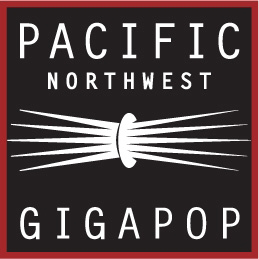Cutting-Edge Research and Education to Benefit From Gigapop
University of Washington Computing & Communications, Windows on Computing, No. 23, Spring 1999
http://www.washington.edu/computing/windows/issue23/gigapop.html
The University of Washington, a key player in bringing the Internet to the Pacific Northwest, is actively addressing the next generation of Internet challenges: efficient and reliable data exchange over significantly increased bandwidths. The UW is bringing its expertise to bear on these issues by participating in several nationwide high-bandwidth initiatives:
- Internet 2
- The Abilene network, an ultra high-speed network backbone supporting research
- The NSF's (National Science Foundation) vBNS, very high performance Backbone Network Service
These Internet Protocol (IP) networks move data over large circuits at volumes up to four hundred times greater than today's commodity Internet.
The newly designed Pacific/ Northwest (P/NW) Gigapop is the focal point in the Pacific Northwest for these high-bandwidth networks. Coverage of service may eventually include the entire Pacific Rim.
"The stage is set for a new era of real-time, data-intensive information exchange," predicts Ron Johnson, UW's vice president for Computing and Communications and vice provost. "It will become increasingly common to access 24-hour-a-day educational and research TV programs through your computer, and for physicians to perform real-time surgery with multiple specialists advising from remote locations."
What Is a Gigapop?
A Gigapop is a regional data transfer center that efficiently moves large volumes of data between regional networks. Because this "point of presence" (or POP) connects with gigabit networks to transfer data, it is commonly referred to as a "gigapop."
How fast a binary digit, or bit, is transmitted between computers is usually roughly expressed in thousands or millions of bits per second (Kbps or Mbps). A gigabit network can transmit about a billion bits per second.
A Boon for Researchers
The UW is committed to providing its researchers with leading-edge Internet capabilities. Through the P/NW Gigapop, researchers can effectively utilize these high-bandwidth networks.
"Much of our work involves high data rate astronomy, and it is important that we be able to transfer data quickly and reliably," says Christopher Stubbs, professor of astronomy and physics, who partners with other universities engaged in projects that span the nation and the globe.
One such project involves the telescope at Apache Point, New Mexico. "We sit at our computer screen at the UW and drive the telescope at the observatory, exchanging data and images," explains Stubbs. "Undergraduates can participate in research like this right here in Seattle."
The challenge of moving huge volumes of data around is one of the largest problems facing researchers, according to Stubbs. "There is a mismatch in our ability to generate large amounts--gigabytes and terabytes--of data, and our ability to move it around. Thanks to Steve Corbat and others at C&C;, we are addressing those needs better than ever before."
Who Will Be Connected
Research and education organizations and network service providers will use the P/NW Gigapop to connect to high-performance networks such as Abilene and vBNS.
The initial core of research institutions connecting to the Gigapop include this region's NSF High Performance Connections grant awardees: University of Washington, Washington State University, Montana State University, University of Idaho, and University of Alaska. Premier research sites, including Fred Hutchinson Cancer Research Center, Children's Hospital and Regional Medical Center, and Microsoft Research, plan to connect in the early stages of this service as well.
Benefits for All Involved
Institutions need only connect to the P/NW Gigapop to gain access to both the high performance Internet2 networks and to the commercial networks via circuit sizes that include Gigabit Ethernet, OC-12, OC-3, and DS-3 (that transmit at 1000, 622, 155, and 45 Mbps, or millions of bits per second, respectively).
If two universities or companies that want to share their research are both connected to the P/NW Gigapop, they can do so without their network traffic being routed through California. Specifically, connecting to the P/NW Gigapop offers organizations and companies such as the UW, Microsoft, and Boeing these benefits:
- Facilitates participation in newly developed and deployed national high-speed networks
- Increases the reliability and efficiency with which data from high-bandwidth applications gets to its intended locations
- Provides a vehicle through which cutting-edge applications can be developed and delivered
- Consolidates the region's high-bandwidth research network services within one quality telecommunications facility at the region's premier telecommunications hub
- Fosters collaboration between regional entities, contributing to the region's future economic well-being
Researchers and others involved in developing and using innovative, cutting-edge, high-bandwidth applications in such areas as meteorology, astronomy, health sciences, computer science, and oceanography will enjoy the initial advantages of being connected to the Gigapop. Those developing protocols to increase the efficiency with which data is transported on the Internet will also be among the first beneficiaries. It is entirely likely that these developments will, as they are refined over time, become the norm both in research as well as in commerce.
"By connecting to the P/NW Gigapop, entities throughout the Pacific Northwest will conveniently and efficiently utilize their high-bandwidth applications for research, education, and commerce," says Terry Gray, UW's director of Networks and Distributed Computing.
For More Information
The P/NW Gigapop, developed by UW's Computing & Communications, has received strong start-up support from the Washington State Legislature.
The Gigapop facilities are physically located at the Westin building in downtown Seattle and at the main computing center on the UW Seattle campus. The Westin location is the primary focal point for telecommunications in the Pacific Northwest and is occupied by major backbone service providers as well as Internet Service Providers.
Visit the P/NW Gigapop Web site, or contact gigapop-info@pnw-gigapop.net for more information.

